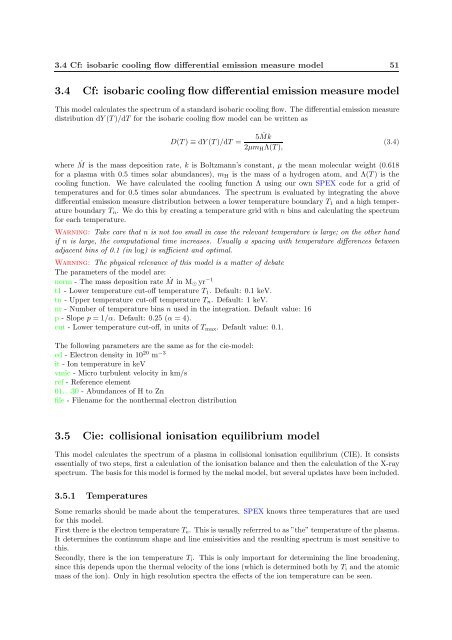SPEX User's Manual - SRON
SPEX User's Manual - SRON
SPEX User's Manual - SRON
You also want an ePaper? Increase the reach of your titles
YUMPU automatically turns print PDFs into web optimized ePapers that Google loves.
3.4 Cf: isobaric cooling flow differential emission measure model 51<br />
3.4 Cf: isobaric cooling flow differential emission measure model<br />
This model calculates the spectrum of a standard isobaric cooling flow. The differential emission measure<br />
distribution dY (T)/dT for the isobaric cooling flow model can be written as<br />
D(T) ≡ dY (T)/dT =<br />
5Ṁk<br />
2µm H Λ(T),<br />
(3.4)<br />
where Ṁ is the mass deposition rate, k is Boltzmann’s constant, µ the mean molecular weight (0.618<br />
for a plasma with 0.5 times solar abundances), m H is the mass of a hydrogen atom, and Λ(T) is the<br />
cooling function. We have calculated the cooling function Λ using our own <strong>SPEX</strong> code for a grid of<br />
temperatures and for 0.5 times solar abundances. The spectrum is evaluated by integrating the above<br />
differential emission measure distribution between a lower temperature boundary T 1 and a high temperature<br />
boundary T n . We do this by creating a temperature grid with n bins and calculating the spectrum<br />
for each temperature.<br />
Warning: Take care that n is not too small in case the relevant temperature is large; on the other hand<br />
if n is large, the computational time increases. Usually a spacing with temperature differences between<br />
adjacent bins of 0.1 (in log) is sufficient and optimal.<br />
Warning: The physical relevance of this model is a matter of debate<br />
The parameters of the model are:<br />
norm - The mass deposition rate Ṁ in M ⊙ yr −1<br />
t1 - Lower temperature cut-off temperature T 1 . Default: 0.1 keV.<br />
tn - Upper temperature cut-off temperature T n . Default: 1 keV.<br />
nr - Number of temperature bins n used in the integration. Default value: 16<br />
p - Slope p = 1/α. Default: 0.25 (α = 4).<br />
cut - Lower temperature cut-off, in units of T max . Default value: 0.1.<br />
The following parameters are the same as for the cie-model:<br />
ed - Electron density in 10 20 m −3<br />
it - Ion temperature in keV<br />
vmic - Micro turbulent velocity in km/s<br />
ref - Reference element<br />
01. . .30 - Abundances of H to Zn<br />
file - Filename for the nonthermal electron distribution<br />
3.5 Cie: collisional ionisation equilibrium model<br />
This model calculates the spectrum of a plasma in collisional ionisation equilibrium (CIE). It consists<br />
essentially of two steps, first a calculation of the ionisation balance and then the calculation of the X-ray<br />
spectrum. The basis for this model is formed by the mekal model, but several updates have been included.<br />
3.5.1 Temperatures<br />
Some remarks should be made about the temperatures. <strong>SPEX</strong> knows three temperatures that are used<br />
for this model.<br />
First there is the electron temperature T e . This is usually referrred to as ”the” temperature of the plasma.<br />
It determines the continuum shape and line emissivities and the resulting spectrum is most sensitive to<br />
this.<br />
Secondly, there is the ion temperature T i . This is only important for determining the line broadening,<br />
since this depends upon the thermal velocity of the ions (which is determined both by T i and the atomic<br />
mass of the ion). Only in high resolution spectra the effects of the ion temperature can be seen.

















